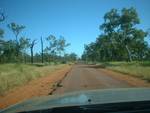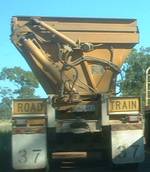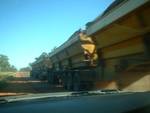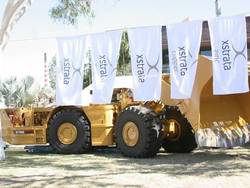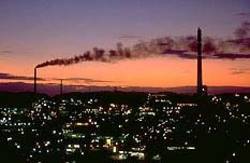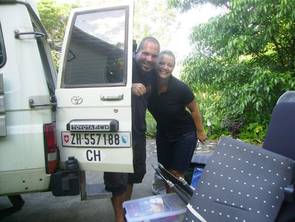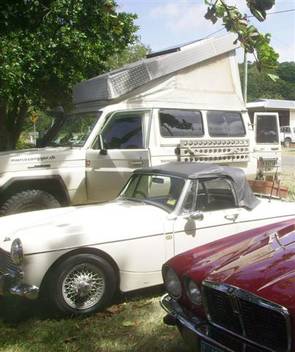News from "Down Under"
Dear Reader
My name is Ursula Simak. I live in North Queensland, Australia. From time to time I will send you short stories from this part of the world. I hope you will enjoy reading them.
Cheerio! U.Simak
- May, 2008 "Road Trains"; see above
- July, 2008 "Sydney"
- Dezember, 2008 Christmas in Australia
- April, 2009 Joyce & Marco Zangger, Zurich: One-year trip around Australia; see above
Road Trains
DON’T TANGLE WITH A ROAD TRAIN
A couple of weeks ago we were travelling up the LYND HIGHWAY, from Charters Towers to Mt. Garnet, a distance of about 450km, in Outback North Queensland in Australia. Also it is called a “Highway”, it is nothing more than a single lane bitumen road with narrow gravel shoulders on both sides.
There are lots and lots of mining places out that way. The coal or whatever else it might be has to be transported to the coast where it is shipped overseas. Therefore various Transport Groups run Road Trains up and down many of those very poor “Highways”. You wish there were Railway Tracks and Trains to execute this very dangerous task of transporting the goods, but no one ever was building them.
Road Trains run 24 hours a day – 7 days a week. Every 5 to 10 minutes one of those heavyweights is passing you and it is a terrifying moment each time.
Those monsters can be up to 55 metres long, towing 4 to 5 trailers (the length of 10 cars). They weigh up to 130 tons so it could take them up to 3 to 4 kilometres to reach their nominated speed and that goes for braking as well.
There are rules on how you have to share the road with Road Trains:
Slow down, pull on to the shoulder of the road and stop until the Road Train has passed.
Be prepared for them to sway side-to-side, especially the last trailer. So make sure that you go well off the bitumen.
Expect Road Trains to stay on the bitumen, you have to go sideway.
Always be patient – you want to stay alive!
If you plan to overtake allow at least one kilometre of clear road ahead.
U. Simak / 3.5.2008Waltzing Matilda - durch Australiens Steppe; Touring, 15/2008 Der Matilda Highway, benannt nach Australiens inoffizieller Landeshymne Waltzing Matilda, führt durch das geschichtsträchtige Queensland. Ein Abenteuer mit Charme.
Read the following text about the danger of mining places - from an Australian newspaper - discussed in spring 2008
Lead testing in Mount Isa
Mount Isa is a mining town located in about 1000 km west of Townsville in North Queensland, Australia. Xstrata, a giant Swiss Mining Company, owns the mine there.
The novelist Vance Palmer wrote in one of his books about Mount Isa: “There’s nothing much to catch the eye. It’s bone-dry country, twisted shrubs and spinifex, and the hills are mostly humps of rock where a goat would find it hard to pick up a feed. … “
Today Mount Isa has got the most highly mechanised mines in the world. It’s the world’s biggest single producer of silver and lead and it is amongst the world’s top ten for copper and zinc. It is also one of the few areas in the world where the four minerals are found in close proximity. As Australia’s largest underground mine, it has a daily output of around 35 000 tonnes of ore.
A recently released study found that too many children had too high blood lead levels. Children with blood lead levels of over 10 micrograms per decilitre are at serious risk of learning and behavioural difficulties. The average reading of an indigenous child was above that of a non-indigenous child. Some of Mount Isa’s indigenous children live in makeshift camps along Death Adder Creek and the Leichhardt River, which Xstrata is currently cleaning up after tests found high metal contamination.
Sustainability Minister Mr McNamara said there were many causes of the problems, including that the town was located in a “highly mineralised” region and that you have to be careful about saying that there was a direct correlation between the lead levels among children and Xstrata’s emissions.
And Queensland Health’s Linda Selvey said it was difficult to pinpoint the source of contamination. She said:” We will continue to do what has been done in the past and we agreed to probably increase what’s been done because a lead level over 10 is not acceptable.” Dr Selvey said the Government would concentrate on improving awareness among the community, in keeping children out of the dirt and wiping down surfaces in the house with wet rags.
Bleivergiftung bei Kindern: Zuger Firma unter Verdacht
Gleichzeitig wurden in den Schweizer Medien vom selben Event berichtet, ausführlicher als in Queensland, wo nur oben aufgeführter Artikel zu finden war.
Dem Rohstoffhandels- und Bergbaukonzern Xstrata mit Sitz in Zug drohen in Australien Klagen. Kinder in der Nähe einer Metallmine weisen einen erhöhten Bleigehalt im Blut auf.
Eine Studie der Gesundheitsbehörden des australischen Bundeslandes Queensland hat nachgewiesen, dass 45 von 400 untersuchten Kindern im Alter von einem bis vier Jahren aus Mount Isa einen erhöhten Bleigehalt im Blut aufweisen, wie die Behörde am Donnerstag in Brisbane bekannt gab. Xstrata betreibt in Mount Isa eine Mine, die Kupfer, Blei und Zink abbaut. Laut der Tageszeitung «The Australian» machen die Ergebnisse der Gesundheitsbehörde den Weg frei für weitere Klagen gegen den Minenbetreiber Xstrata.
Eine australische Anwaltskanzlei hatte bereits im vergangenen Monat eine Strafklage gegen Xstrata eingereicht, um in einem Pilotverfahren den Fall eines sechsjährigen Mädchens aus Mount Isa vor Gericht zu bringen, das an einer Bleivergiftung leide. Gemäss den am Donnerstag veröffentlichten Resultaten wiesen 45 der 400 Kinder einen erhöhten Bleigehalt von über zehn Mikrogramm pro Deziliter Blut auf. Zwei von ihnen wiesen über 20 Mikrogramm auf und wurden an einen Kinderarzt überwiesen.
Von den Kindern mit erhöhten Bleiwerten hatten über 90 Prozent draussen auf dem Erdboden gespielt und über 70 Prozent leben zusammen mit Haustieren. Die Gesundheitsbehörde will nun diese Tests weiterführen und die Staubbekämpfungsmassnahmen in der Gemeinde Mount Isa verstärken, wie sie bekannt gab. Die Verantwortlichen der Xstrata-Mine in Mount Isa kündigten gleichentags an, dass sie die Empfehlungen der Gesundheitsbehörde unterstützen und sicherten ihre Zusammenarbeit zu.
Quelle: AP
www.20min.ch/news/wirtschaft/story/10873214, 22.05.08
Swiss guests at our Parkwood B&B
Joyce & Marco Zangger, Zurich: One-year trip around Australia
Hi there!
It might be interesting for you to know that right now a very adventurous Swiss couple is staying as guests at our Parkwood B&B in the Whitsundays (Qld). Their names are Marco and Joyce and they come from Zurich. They left Switzerland sometimes in the middle of last year for a one-year trip around Australia. A very interesting detail is that they shipped their own Swiss 4WD to Australia after having it fitted out for all possible occurrences. This moment they covered a huge part of the mostly very rugged desert country and they visited a lot of cities as well. Right now they overhaul their vehicle at our place and then they will head up to the Cape York or they will cross the Simpson Desert before going into Darwin and further down the track into the Kimberley’s.
In the attachment you’ll find just two pictures I shot here at our place. But if you are interested in many more then go to www.marcozangger.ch and you will find the most beautiful pictures about that journey around Australia. You’ll find there as well reports (Reiseberichte) in German language. – Marco told me that you could write comments into that website or ask questions as well. You are very welcome!
If you ever venture on a trip like that – once in a lifetime – then don’t forget to stop here at our place. We certainly will enjoy your visit! – And now go and meet Marco and Joyce on their website!
Cheerio!
Ursula Simak, Parkwood B&B, Airlie Beach (type Airlie Beach), Whitsundays, Queensland



